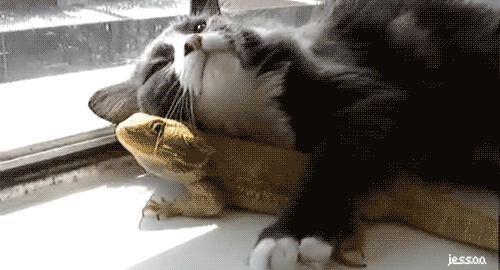Saturday, December 31, 2011
New Year's resolution
New Year's Resolution - I will stop reading Adult magazines. It is 31stDecember- let me have a last look!

Friday, December 30, 2011
Thursday, December 29, 2011
Double Headed Animals
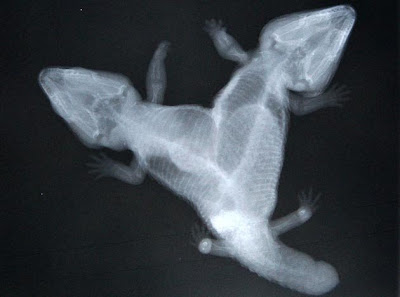 An x-ray of a rescued two headed bobtail, a type of skink, at the Henley Brook Reptile Park on April 22, 2010 in Perth, Australia.
An x-ray of a rescued two headed bobtail, a type of skink, at the Henley Brook Reptile Park on April 22, 2010 in Perth, Australia.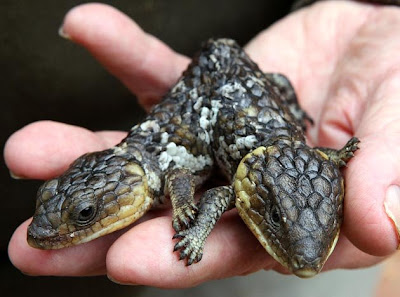 Janus, the Geneva Museum of Natural History’s two-headed Greek tortoise, is presented to the press and the public during the official celebration of its 10th birthday on 05 September 2007.
Janus, the Geneva Museum of Natural History’s two-headed Greek tortoise, is presented to the press and the public during the official celebration of its 10th birthday on 05 September 2007. A Hereford calf with two joining heads is bottle fed at a veterinary clinic in Elk Grove, California on April, 2, 1987 where it was taken by owner Dick Harry. The twelve day old female calf can eat with both mouths but the one being fed is more dominant.
A Hereford calf with two joining heads is bottle fed at a veterinary clinic in Elk Grove, California on April, 2, 1987 where it was taken by owner Dick Harry. The twelve day old female calf can eat with both mouths but the one being fed is more dominant.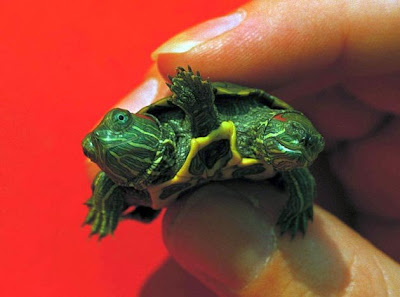 A turtle born with two heads and an extra set of legs between them is held by an employee of a Jenkintown, Pa., pet store on Sept. 22, 1986. The owner of the store said while it was the strangest thing he’d ever seen he had no idea how long it would live.
A turtle born with two heads and an extra set of legs between them is held by an employee of a Jenkintown, Pa., pet store on Sept. 22, 1986. The owner of the store said while it was the strangest thing he’d ever seen he had no idea how long it would live.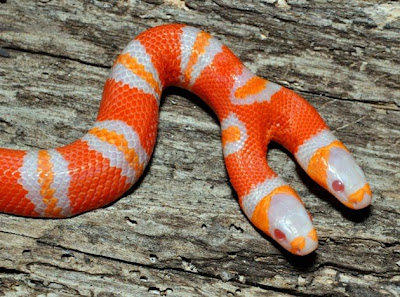 Oct. 28, 2011 photo provided by Daniel Parker of Sunshineserpents.com, a two-headed albino Honduran milk snake is shown in Ridge Manor, Fla. Parker, a University of Central Florida biologist, says that most two-headed snakes have typical coloration. Albino snakes don't have dark pigmentation in their skin. Albino milk snakes appear in bright shades of red, orange and white. The biologist says two-headed snakes have been documented to live as long as 20 years in captivity. But with two brains giving commands to a single body, Parker says the snake would have a difficult time surviving in the wild.
Oct. 28, 2011 photo provided by Daniel Parker of Sunshineserpents.com, a two-headed albino Honduran milk snake is shown in Ridge Manor, Fla. Parker, a University of Central Florida biologist, says that most two-headed snakes have typical coloration. Albino snakes don't have dark pigmentation in their skin. Albino milk snakes appear in bright shades of red, orange and white. The biologist says two-headed snakes have been documented to live as long as 20 years in captivity. But with two brains giving commands to a single body, Parker says the snake would have a difficult time surviving in the wild. Frank and Louie (one name for each face) walks by its owner Marty, at their home in Massachusetts.
Frank and Louie (one name for each face) walks by its owner Marty, at their home in Massachusetts.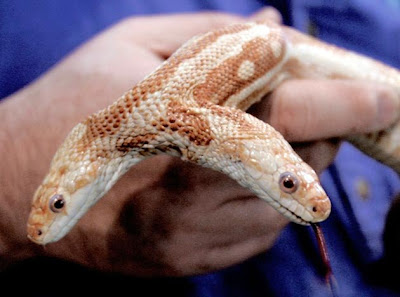 Leonard Sonnenschein, president of the World Aquarium in St. Louis, holds a two-headed albino rat snake. The eight-year-old oddity of nature was known affectionately by fans worldwide as "We" died of natural causes in 2007.
Leonard Sonnenschein, president of the World Aquarium in St. Louis, holds a two-headed albino rat snake. The eight-year-old oddity of nature was known affectionately by fans worldwide as "We" died of natural causes in 2007.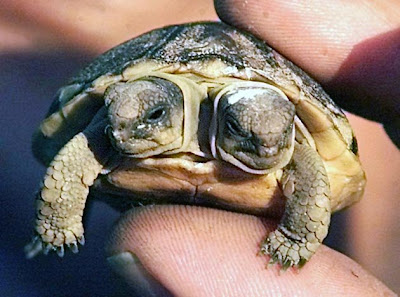 Janus, the Geneva Museum of Natural History’s two-headed Greek tortoise, is presented to the press and the public during the official celebration of its 10th birthday on 05 September 2007.
Janus, the Geneva Museum of Natural History’s two-headed Greek tortoise, is presented to the press and the public during the official celebration of its 10th birthday on 05 September 2007.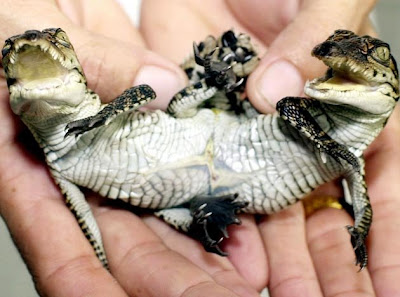 An official shows a two-headed baby crocodile at Samut Prakarn Crocodile Farm on the outskirt of Bangkok. TAn official shows a two-headed baby crocodile at Samut Prakarn Crocodile Farm on the outskirt of Bangkok Monday, June 25, 2001. The crocodile, which shares the bottom part of the body, has eight legs and two tails, was born at this farm three days ago. It is measured at 17-centimeter long and weighs at 70 grams.
An official shows a two-headed baby crocodile at Samut Prakarn Crocodile Farm on the outskirt of Bangkok. TAn official shows a two-headed baby crocodile at Samut Prakarn Crocodile Farm on the outskirt of Bangkok Monday, June 25, 2001. The crocodile, which shares the bottom part of the body, has eight legs and two tails, was born at this farm three days ago. It is measured at 17-centimeter long and weighs at 70 grams.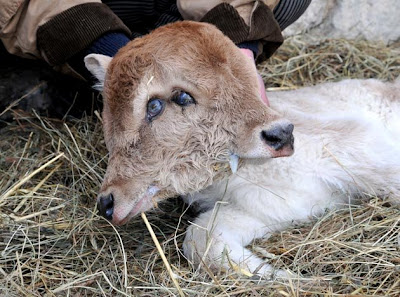 Hakob Avetyan (not pictured) holds a two-headed calf in the Armenian village of Sotk, on January 28, 2011. The two-headed calf was born on January 25 in the Avetyans' cow house. Two-headed people and animals, though rare, have long been known to exist, and been documented.
Hakob Avetyan (not pictured) holds a two-headed calf in the Armenian village of Sotk, on January 28, 2011. The two-headed calf was born on January 25 in the Avetyans' cow house. Two-headed people and animals, though rare, have long been known to exist, and been documented.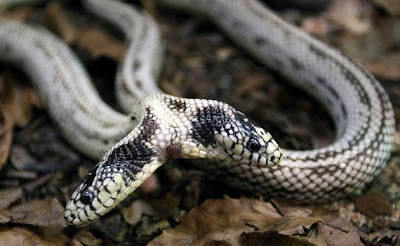 A two-headed snake named Tom and Jerry is pictured 08 May 2008 at the Vivarium exposition in Offenburg, western Germany .
A two-headed snake named Tom and Jerry is pictured 08 May 2008 at the Vivarium exposition in Offenburg, western Germany .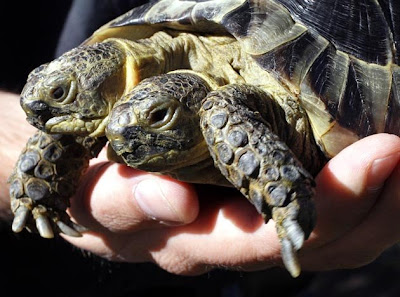 anus, the Geneva Museum of Natural History’s two-headed Greek tortoise, is presented to the press and the public during the official celebration of its 10th birthday on 05 September 2007.
anus, the Geneva Museum of Natural History’s two-headed Greek tortoise, is presented to the press and the public during the official celebration of its 10th birthday on 05 September 2007.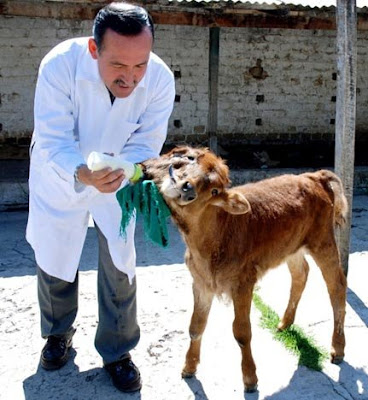 A vet feeds five month two-headed calf "Milagritos" (Little Miracle) in Cajamarca, Peru, on August 19, 2009.
A vet feeds five month two-headed calf "Milagritos" (Little Miracle) in Cajamarca, Peru, on August 19, 2009. A Palestinian farmer holds a two-headed sheep outside his family home in the West Bank al-Fawar refugee camp, near Hebron, on November 9, 2008.
A Palestinian farmer holds a two-headed sheep outside his family home in the West Bank al-Fawar refugee camp, near Hebron, on November 9, 2008.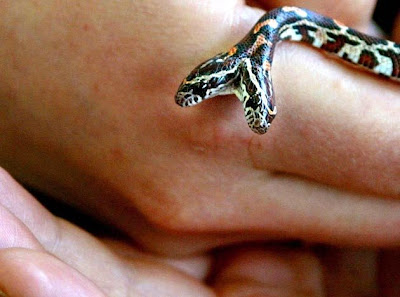 An animal keeper shows a two-headed American Rat Snake in an animal park in Tilburg.
An animal keeper shows a two-headed American Rat Snake in an animal park in Tilburg.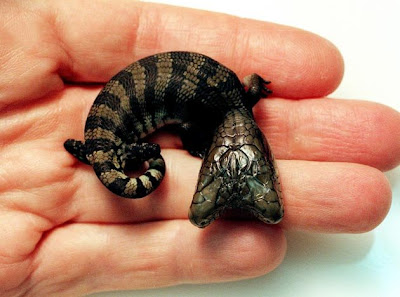 Australian scientists discovered a two headed blue tongue lizard in Sydney on 17th January 2001.The lizard named Trixie has one eye on the far side of each of her heads, as well as a third eye where the two heads connect, and one blue tongue.
Australian scientists discovered a two headed blue tongue lizard in Sydney on 17th January 2001.The lizard named Trixie has one eye on the far side of each of her heads, as well as a third eye where the two heads connect, and one blue tongue.Click Here to View More Photos
Source: Yahoo Photos
Wednesday, December 28, 2011
10 Animals With Incredible Eyes
Eyes are important organs for many living creatures. Some creatures have amazing and complex eyes. Here are 10 animals with incredible and strangest eyes.
10. Tarsier
9. Chameleon
Chameleons have very unusual eyes. Their eyelids are fused, and cover almost the entire eyeball, except for a small hole to let the pupil see through. Each eye can be moved independently from the other, which means that the chameleon has a full 360 degree field of vision so the chameleon can scan for prey and potential threats at the same time.
When the chameleon sees a potential prey, it focuses both eyes in the same direction, gaining stereoscopic vision. It’s very important because the chameleon captures prey by shooting out its tongue at high speed, a technique that requires a very precise distance and depth perception. Chameleons have very sharp eyesight, being able to see an insect several meters away, and just like the tarsier, they can see ultraviolet light.
8. Dragonfly
Dragonfly’s eyes are so big that they cover almost the entire head, giving it a helmeted appearance, and a full 360 degree field of vision. These eyes are made up of 30,000 visual units called ommatidia, each one containing a lens and a series of light sensitive cells. Their eyesight is superb; they can detect colors and polarized light, and are particularly sensitive to movement, allowing them to quickly discover any potential prey or enemy.
Dragonflies also have three smaller eyes named ocelli which can detect movement faster than the huge compound eyes can. These ocelli quickly send visual information to the dragonflies’ motor centers, allowing it to react in a fraction of a second and perhaps explaining the insect’s formidable acrobatic skills. Some wasps and flies have ocelli too, but Dragonflies do have the most developed ones.
7. Leaf tailed gecko
Leaf tailed geckos have pretty surreal-looking eyes. Their pupils are vertical and have a series of “pinholes” which widen at night, allowing these lizards to pick up as much light as possible. These eyes also have many more light sensitive cells than human eyes, giving the animal the ability to detect objects and even to see colors at night. The Leaf Tailed gecko and other nocturnal gecko species can see up to 350 times better than human can in dim light.
Leaf tailed geckos also have a series of strange, intricate eye patterns, which provide camouflage. They lack eyelids; their eyes are protected by a transparent membrane. They are often seen cleaning this membrane with their tongue.
6. Colossal squid
The Colossal squid is the largest invertebrate known to science; it also has the largest eyes in the animal kingdom. Each eye can be up to 30 cm across. These huge eyes allow the squid to see in dim light conditions, very useful for hunting at 2000 meters below the surface.
The Colossal squid has stereoscopic vision, having a greater ability to judge distances. Even more amazing, each eye has a built-in “headlight”, an organ known as a photophore which can produce light so that whenever the Colossal squid focuses its eyes to the front, the photophores produce enough light for the squid to see its prey in the dark.
5. Four eyed fish
Despite their name, four eyed fish have only two eyes. These eyes are divided by a band of tissue and each half of the eye has a pupil of its own. This allows the four eyed fish to see perfectly both above and below the waterline at the same time, scanning for both prey and predators. The upper half of the eyeball is adapted to vision in air, while the lower half is adapted to underwater vision.
Although both halves of the eye use the same lens, the thickness and curve of the lens is different in the upper and lower eye halves, thus correcting for the different behavior of light in air and water. This means that when the four eyed fish is completely submerged, the upper halves of the eyes are out of focus. Fortunately, the fish spends almost its entire life in the surface, and it only has to dive completely once in a while to prevent the upper halves of the eyes from dehydrating. Four eyed fish can be found in Mexico and Central America, as well as Northern South America.
4. Stalk eyed fly
Stalk eyed flies get their name from the long projections from the sides of the head with the eyes and antennae at the end. Males’ eyestalks are longer than females and it has been confirmed that females prefer males with long eyestalks.
Males during mating season often stand face to face and measure their eyestalk’s length; the one with the greatest “eye span” is recognized as the winner. They also have the extraordinary ability to enlarge their eyestalks by ingesting air through their mouth and pumping it through ducts in the head to the eyestalks.
3. Spookfish
The spookfish has some of the most bizarre eye structures known to science. Each eye has a lateral swelling called a diverticulum, separated from the main eye by a septum. The main eye has a lens and functions in a similar way to other animal eyes while the diverticulum has a curved, composite mirror composed of many layers of what seem to be guanine crystals.
This “mirror” is superior at gathering light than the normal eye; the diverticulum reflects light and focuses it onto the retina allowing the fish to see both up at down at the same time. This deep water, ghostly-looking fish is the only vertebrate known to use a mirror eye structure to see, as well as the usual lens. Spookfish live at a depth of 1000-2000 meters feeding on small crustaceans and plankton.
2. Ogre faced spider
Spiders are popularly known for having many eyes. The Ogre-faced spider has six eyes, but it looks as if it only had two because the middle pair is greatly enlarged. This is an adaptation for a nocturnal lifestyle; ogre faced spiders have superb night vision not only because of their huge eyes, but because of an extremely light sensitive layer of cells covering them. This membrane is so sensitive. It’s destroyed at dawn and a new one is produced every night.
Ogre faced spiders can see perfectly at night even though they lack tapetum lucidum, a reflective membrane that helps others spiders (and other predators such as cats) to see in low light conditions. Scientists believe that ogre faced spiders can see up to 100 times better than humans at night.
1. Mantis shrimp
The mantis shrimp is not actually a shrimp, but a different kind of crustacean from the Stomatopoda order. The mantis shrimp is so aggressive and has formidable weaponry. They have an extremely sharp and powerful claw that can split a human finger in two or even break a glass aquarium with one single strike. The mantis shrimp are voracious predators found mostly in tropical waters.
Their eyes are compound, like those of the dragonfly, but they have a far smaller number of ommatidia (about 10.000 per eye). However, in the mantis shrimp each ommatidia row has a particular function. For example, some of them are used to detect light, others to detect color, etc.
Mantis shrimp have much better color vision than humans, as well as ultraviolet, infrared and polarized light vision, thus having the most complex eyesight of any animal known. Their eyes have 12 types of color receptors, whereas humans have only three. The eyes are located at the end of stalks, and can be moved independently from each other, rotating up to 70 degrees. Interestingly, the visual information isn't processed by the brain but the eyes themselves.
Even more bizarre; each of the mantis shrimp’s eyes is divided in three sections allowing the creature to see objects with three different parts of the same eye. In other words, each eye has “trinocular vision” and complete depth perception, meaning that if a mantis shrimp lost an eye, its remaining eye would still be able to judge depth and distance as well as a human with his two eyes. Scientists are only starting to understand the mysteries of Stomatopod vision; for the moment, we can only imagine what the world really looks like to a mantis shrimp.
Source: 10 Animals With Incredible Eyes
10. Tarsier
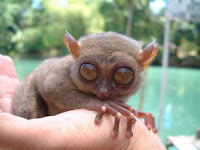 |
| Tarsier |
The tarsier has enormous eyes, the largest of any mammal, relative to body size. Each eye is weighing more than its brain. These enormous eyes can’t be turn in their sockets because they are fixed in the skull. To compensate for this, the tarsier has a very flexible neck, and can rotate its head 180 degrees, just like an owl, to scan for potential prey or predators.
The tarsier has extremely acute eyesight and superb night vision; it has even been suggested that they may be able to see ultraviolet light. On the other hand, they seem to have very poor color vision, as is the case with many nocturnal animals (including house cats and owls, for example). This small nocturnal primate can be found in the rainforests of South Eastern Asia.
The tarsier has extremely acute eyesight and superb night vision; it has even been suggested that they may be able to see ultraviolet light. On the other hand, they seem to have very poor color vision, as is the case with many nocturnal animals (including house cats and owls, for example). This small nocturnal primate can be found in the rainforests of South Eastern Asia.
9. Chameleon
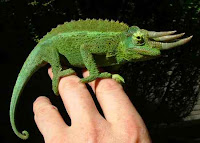 |
| chameleon |
When the chameleon sees a potential prey, it focuses both eyes in the same direction, gaining stereoscopic vision. It’s very important because the chameleon captures prey by shooting out its tongue at high speed, a technique that requires a very precise distance and depth perception. Chameleons have very sharp eyesight, being able to see an insect several meters away, and just like the tarsier, they can see ultraviolet light.
8. Dragonfly
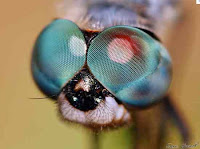 |
| dragonfly |
Dragonflies also have three smaller eyes named ocelli which can detect movement faster than the huge compound eyes can. These ocelli quickly send visual information to the dragonflies’ motor centers, allowing it to react in a fraction of a second and perhaps explaining the insect’s formidable acrobatic skills. Some wasps and flies have ocelli too, but Dragonflies do have the most developed ones.
7. Leaf tailed gecko
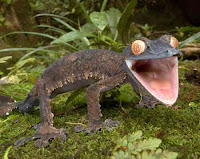 |
| leaf tailed gecko |
Leaf tailed geckos also have a series of strange, intricate eye patterns, which provide camouflage. They lack eyelids; their eyes are protected by a transparent membrane. They are often seen cleaning this membrane with their tongue.
6. Colossal squid
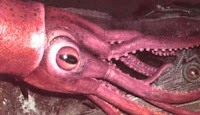 |
| colossal squid |
The Colossal squid has stereoscopic vision, having a greater ability to judge distances. Even more amazing, each eye has a built-in “headlight”, an organ known as a photophore which can produce light so that whenever the Colossal squid focuses its eyes to the front, the photophores produce enough light for the squid to see its prey in the dark.
5. Four eyed fish
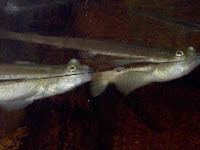 |
| four eyed fish |
Although both halves of the eye use the same lens, the thickness and curve of the lens is different in the upper and lower eye halves, thus correcting for the different behavior of light in air and water. This means that when the four eyed fish is completely submerged, the upper halves of the eyes are out of focus. Fortunately, the fish spends almost its entire life in the surface, and it only has to dive completely once in a while to prevent the upper halves of the eyes from dehydrating. Four eyed fish can be found in Mexico and Central America, as well as Northern South America.
4. Stalk eyed fly
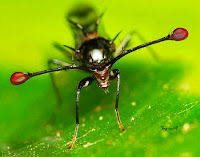 |
| stalk eyed fly |
Males during mating season often stand face to face and measure their eyestalk’s length; the one with the greatest “eye span” is recognized as the winner. They also have the extraordinary ability to enlarge their eyestalks by ingesting air through their mouth and pumping it through ducts in the head to the eyestalks.
3. Spookfish
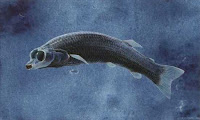 |
| spookfish |
This “mirror” is superior at gathering light than the normal eye; the diverticulum reflects light and focuses it onto the retina allowing the fish to see both up at down at the same time. This deep water, ghostly-looking fish is the only vertebrate known to use a mirror eye structure to see, as well as the usual lens. Spookfish live at a depth of 1000-2000 meters feeding on small crustaceans and plankton.
2. Ogre faced spider
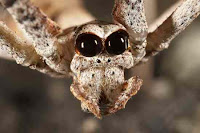 |
| ogre faced spider |
Ogre faced spiders can see perfectly at night even though they lack tapetum lucidum, a reflective membrane that helps others spiders (and other predators such as cats) to see in low light conditions. Scientists believe that ogre faced spiders can see up to 100 times better than humans at night.
1. Mantis shrimp
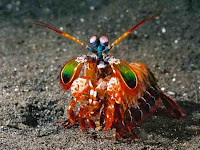 |
| mantis shrimp |
Their eyes are compound, like those of the dragonfly, but they have a far smaller number of ommatidia (about 10.000 per eye). However, in the mantis shrimp each ommatidia row has a particular function. For example, some of them are used to detect light, others to detect color, etc.
Mantis shrimp have much better color vision than humans, as well as ultraviolet, infrared and polarized light vision, thus having the most complex eyesight of any animal known. Their eyes have 12 types of color receptors, whereas humans have only three. The eyes are located at the end of stalks, and can be moved independently from each other, rotating up to 70 degrees. Interestingly, the visual information isn't processed by the brain but the eyes themselves.
Even more bizarre; each of the mantis shrimp’s eyes is divided in three sections allowing the creature to see objects with three different parts of the same eye. In other words, each eye has “trinocular vision” and complete depth perception, meaning that if a mantis shrimp lost an eye, its remaining eye would still be able to judge depth and distance as well as a human with his two eyes. Scientists are only starting to understand the mysteries of Stomatopod vision; for the moment, we can only imagine what the world really looks like to a mantis shrimp.
Source: 10 Animals With Incredible Eyes
Subscribe to:
Posts (Atom)


















